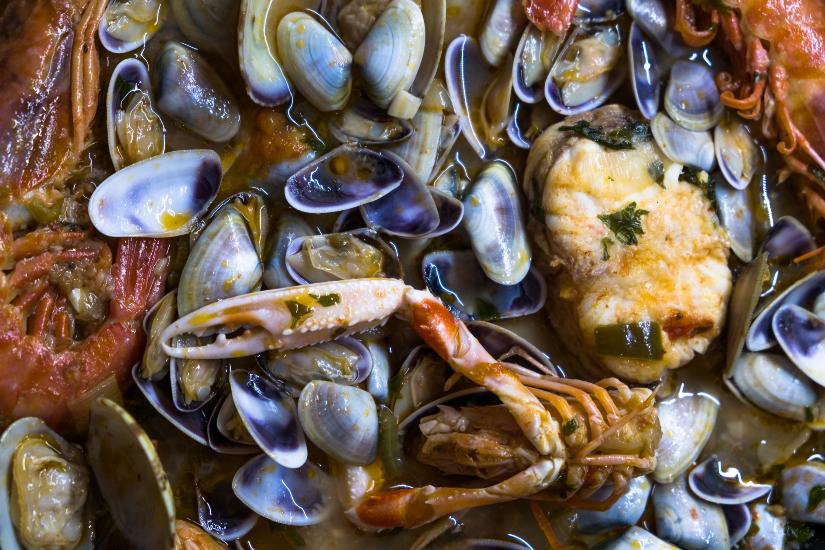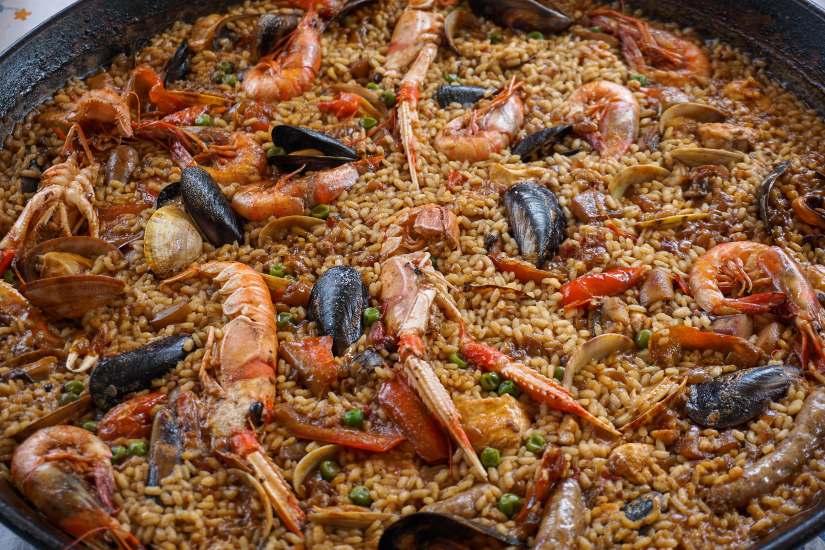Food is a fundamental part of a culture and getting to know the typical dishes from Spain is almost mandatory if you are coming to study one of our Spanish courses in Spain.
Typical Spanish food: much more than tapas
Before going over the most popular Spanish dishes, you should know that most of them have local or regional varieties.
For example, paella is a very popular dish throughout the country, but the original and most recognized is the Valencian one.
Something similar happens with salmorejo: you can try it in many cities, but the most famous is the one from Andalusia and, specifically, the one from Córdoba.
On the other hand, our location and climate, as well as the fact that we have sea, mountains, rain-fed zones and orchard areas, allows the Spanish gastronomy to offer a great variety of dishes and sweets.
Most of them are made with high quality ingredients such as cereals, vegetables, fresh meat and fish and, of course, olive oil, one of the symbols of the Mediterranean diet.

TOP 10 typical Spanish dishes
Although the classics of typical Spanish food are tapas, our cuisine is made up of many other dishes, such as stews, casseroles, salads, soups and creams, with which it is possible to cope with the heat in summer and stand the cold in winter.
Discover our 14 best day trips from Valencia!
Tortilla de patata
One of the star dishes of Spanish cuisine and also one of the most humble, simple, … and tasty.
Due to its popularity, the tortilla de patata, also called “tortilla española”, has many versions.
All of them are prepared with three common ingredients: whisked egg, baked/fried potatoes and olive oil.
It is up to the chef to add onion or bell pepper, serve it rare or make it thinner or thicker.
Ham croquettes
If we have to select a “grandmother’s recipe” of Spanish cuisine, that is croquettes, which are a must in every home.
Although there are many types of croquettes, the most popular are ham croquettes.
It is a rather time-consuming dish, but the result is worth it: you have to chop the ham, add some chopped onion, fry both ingredients in a frying pan and make a sauce with flour, butter, and milk (bechamel) so that all the elements are bound together in a smooth-textured dough.
When this dough is cold, make “little balls” that are covered with breadcrumbs and then fried in a frying pan with olive oil.
If you try them, you will certainly repeat!
Gazpacho and salmorejo
Gazpacho and salmorejo are two cold creams that are two of the most popular traditional Spanish recipes.
They are both consumed mainly during the summer.
Their main ingredient is tomato, which is mashed with garlic, bread and olive oil until it becomes a more or less thick cream.
For the gazpacho recipe, other fresh vegetables are added, such as onion, cucumber or bell pepper.
Gazpacho and salmorejo can be eaten alone or served with diced ham and hard-boiled egg.
Pisto
Pisto is one of the most popular Spanish dishes.
This dish is made with peppers and other seasonal vegetables common in typical Spanish recipes, such as onion, tomato, zucchini, leek or eggplant.
Their presentations are varied.
For example, in Catalonia, this dish is called “escalivada” and the vegetables are roasted, cut into strips and left to cool in the refrigerator with a drizzle of olive oil and salt.
In Castilla La Mancha, where it is very famous, pisto is prepared in a frying pan and served hot, served with a poached egg.
But do you know what all pistos have in common? You’ll need a good piece of bread to dip in the dish.

Valencian Paella
Paella is one of the most famous dishes in the world and is immediately associated with the Spanish cuisine.
The most famous is the Valencian paella, but in Valencia and in Spain you can try other delicious rice dishes, such as arroz a banda, arroz del senyoret, arroz negro or arroz al horno.
Cocido
Cocido is one of Spain’s typical winter dishes, when hot and energetic meals are consumed to face the cold.
This traditional dish is within the reach of all budgets, and is made with meats, vegetables and vegetables (chickpeas) cooked, in the same pot, over low heat.
The most famous is the cocido madrileño, which is served in a curious way: first a soup with noodles, then chickpeas sautéed with vegetables, and, finally, meats and sausages.
Migas
This is one of the traditional Spanish dishes with more variations depending on the area where you try it.
It belongs to the so-called “cocina de aprovechamiento” because its base is the bread left over from the previous day (or days).
The bread, cut into small pieces, is fried with garlic and olive oil.
Then, ingredients such as sausages (chorizo, ham, bacon, etc.) or chorizo peppers are added.
In some regions migas are served with a fried egg and, in others, with grapes, being a very popular dish in the fall.
Hake with green sauce
Spanish food in coastal areas is famous for its fish dishes.
One of the most popular is hake in green sauce, a nutritious and tasty recipe, in which the fish is prepared in a clay casserole with a sauce made with fish stock, garlic, onion, white wine, a bit of flour to thicken it and parsley (hence its color and name).
The sauce is left to rest before serving, so that the flavors blend well.
Sometimes clams are added to this stew to add extra flavor to the dish.
Churros
In a ranking of typical Spanish food, we cannot miss the sweets. Specifically, churros, which can be eaten for breakfast or as a snack, together with hot chocolate or sprinkled with powdered sugar.
Their dough is simple to prepare and, although it is typical to eat them during the winter or on special dates (such as Christmas), there are those who can’t resist eating them all year round.
Discover the best Christmas sweets in Spain.
Torrijas
We finish this selection of typical Spanish foods with a delicious pastry: torrijas.
As with migas, this desert is made with bread that has become hard, and in this case, it is cut into slices.
The slices are dipped in milk infused with orange (or lemon) peel and a cinnamon stick and then in whisked egg, before frying in a pan with plenty of hot oil.
Once they turn golden brown on both sides, the torrijas are covered with a mixture of sugar and cinnamon.
Discover the secrets of Spanish gastronomy with Españolé
At Españolé, our Spanish school in Spain, you will be able to improve your Spanish thanks to our intensive courses, which are practical and personalized.
Get to know our Spanish courses in Spain.
But that’s not all. You will also have the opportunity to get to know closely the habits and traditions of our country, and you will have fun and share many other things with students from other cultures.
And of course, you will get to taste the most popular Spanish dishes, so get ready to lick your fingers!
